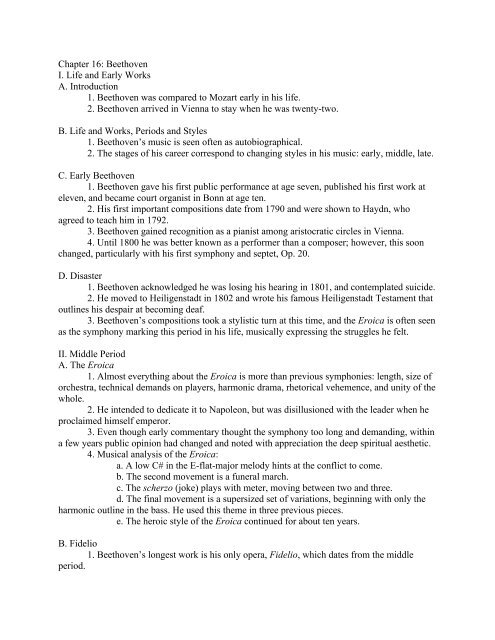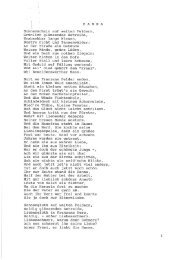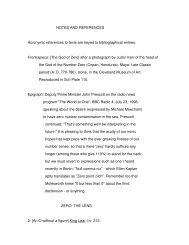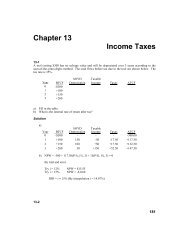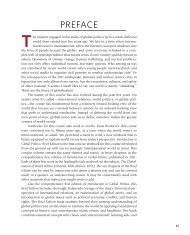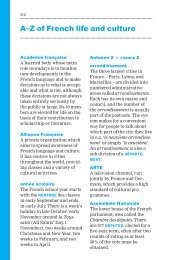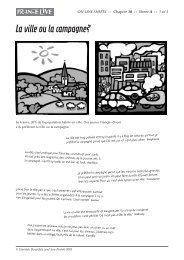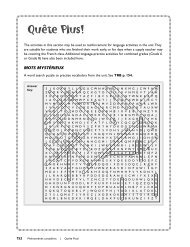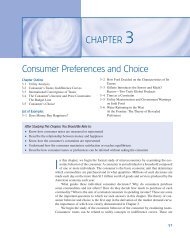Chapter 16: Beethoven I. Life and Early Works A. Introduction 1 ...
Chapter 16: Beethoven I. Life and Early Works A. Introduction 1 ...
Chapter 16: Beethoven I. Life and Early Works A. Introduction 1 ...
You also want an ePaper? Increase the reach of your titles
YUMPU automatically turns print PDFs into web optimized ePapers that Google loves.
<strong>Chapter</strong> <strong>16</strong>: <strong>Beethoven</strong><br />
I. <strong>Life</strong> <strong>and</strong> <strong>Early</strong> <strong>Works</strong><br />
A. <strong>Introduction</strong><br />
1. <strong>Beethoven</strong> was compared to Mozart early in his life.<br />
2. <strong>Beethoven</strong> arrived in Vienna to stay when he was twenty-two.<br />
B. <strong>Life</strong> <strong>and</strong> <strong>Works</strong>, Periods <strong>and</strong> Styles<br />
1. <strong>Beethoven</strong>’s music is seen often as autobiographical.<br />
2. The stages of his career correspond to changing styles in his music: early, middle, late.<br />
C. <strong>Early</strong> <strong>Beethoven</strong><br />
1. <strong>Beethoven</strong> gave his first public performance at age seven, published his first work at<br />
eleven, <strong>and</strong> became court organist in Bonn at age ten.<br />
2. His first important compositions date from 1790 <strong>and</strong> were shown to Haydn, who<br />
agreed to teach him in 1792.<br />
3. <strong>Beethoven</strong> gained recognition as a pianist among aristocratic circles in Vienna.<br />
4. Until 1800 he was better known as a performer than a composer; however, this soon<br />
changed, particularly with his first symphony <strong>and</strong> septet, Op. 20.<br />
D. Disaster<br />
1. <strong>Beethoven</strong> acknowledged he was losing his hearing in 1801, <strong>and</strong> contemplated suicide.<br />
2. He moved to Heiligenstadt in 1802 <strong>and</strong> wrote his famous Heiligenstadt Testament that<br />
outlines his despair at becoming deaf.<br />
3. <strong>Beethoven</strong>’s compositions took a stylistic turn at this time, <strong>and</strong> the Eroica is often seen<br />
as the symphony marking this period in his life, musically expressing the struggles he felt.<br />
II. Middle Period<br />
A. The Eroica<br />
1. Almost everything about the Eroica is more than previous symphonies: length, size of<br />
orchestra, technical dem<strong>and</strong>s on players, harmonic drama, rhetorical vehemence, <strong>and</strong> unity of the<br />
whole.<br />
2. He intended to dedicate it to Napoleon, but was disillusioned with the leader when he<br />
proclaimed himself emperor.<br />
3. Even though early commentary thought the symphony too long <strong>and</strong> dem<strong>and</strong>ing, within<br />
a few years public opinion had changed <strong>and</strong> noted with appreciation the deep spiritual aesthetic.<br />
4. Musical analysis of the Eroica:<br />
a. A low C# in the E-flat-major melody hints at the conflict to come.<br />
b. The second movement is a funeral march.<br />
c. The scherzo (joke) plays with meter, moving between two <strong>and</strong> three.<br />
d. The final movement is a supersized set of variations, beginning with only the<br />
harmonic outline in the bass. He used this theme in three previous pieces.<br />
e. The heroic style of the Eroica continued for about ten years.<br />
B. Fidelio<br />
1. <strong>Beethoven</strong>’s longest work is his only opera, Fidelio, which dates from the middle<br />
period.
2. It was initially a flop <strong>and</strong> subsequently revised (three versions <strong>and</strong> four overtures now<br />
exist).<br />
3. The final chorus of Fidelio is one of several works that moves the work from light to<br />
dark (see also his Fifth Symphony).<br />
C. The Fifth <strong>and</strong> Fate<br />
1. While the Fifth Symphony is <strong>Beethoven</strong>’s most famous work today, it was not during<br />
his lifetime.<br />
2. The symphony also includes a feature of his music known as organicism: All<br />
movements grow out of a single germ/idea.<br />
3. Several unexpected passages, such as the short oboe cadenza, force the listener to<br />
question why the music behaves as it does. This is a new self-conscious subjectivity, <strong>and</strong> it is<br />
purely instrumental music, making a point without reference to text.<br />
4. The second movement is an unusual variation set with two alternating themes.<br />
5. The last two movements are linked.<br />
6. For the design of a symphony to cover all four movements, the overarching tension<br />
<strong>and</strong> release, the sheer power of <strong>Beethoven</strong>’s Fifth demonstrates what Hoffmann called “the spirit<br />
world of infinite.”<br />
D. “More Expression of Feeling than Tone Painting”: The Pastoral Symphony<br />
1. Not all of <strong>Beethoven</strong>’s middle period works are dynamic <strong>and</strong> heroic. He wrote the<br />
Fifth <strong>and</strong> Sixth symphonies simultaneously, <strong>and</strong> they were premiered at the same concert.<br />
2. The Sixth Symphony is intentionally programmatic.<br />
3. He gave each movement a descriptive title.<br />
E. Concert <strong>Life</strong> in <strong>Beethoven</strong>’s Vienna<br />
1. <strong>Beethoven</strong> planned a special concert in 1808, <strong>and</strong> it included the premieres of both the<br />
Fifth <strong>and</strong> Sixth Symphonies <strong>and</strong> the Fourth Piano Concerto, among other works.<br />
2. Because of a lack of st<strong>and</strong>ing orchestras, enough rehearsals, etc., concert performances<br />
such as this one were probably subpar by today’s st<strong>and</strong>ards.<br />
F. Struggle <strong>and</strong> Victory<br />
1. The way <strong>Beethoven</strong>’s music was described by Hoffmann <strong>and</strong> others cast it as<br />
“universal”—as if the values <strong>and</strong> aesthetics extended equally to everyone.<br />
2. <strong>Beethoven</strong>’s music has been interpreted as “manly” <strong>and</strong> has been used to praise<br />
aggression, violence, <strong>and</strong> victory. Some even associate it with German national character. This is<br />
not always positive.<br />
III. Later Period<br />
A. Rising Fame <strong>and</strong> Decreasing Productivity<br />
1. After 1808, <strong>Beethoven</strong> took his music in yet another direction, one marked by a period<br />
of depression.<br />
2. Contemporaries such as Goethe found him socially difficult, if genius.<br />
3. In the summer of 1812 he penned the letter to the “Immortal Beloved,” found in his<br />
effects after his death.
4. In 1815 he sought custody of his nephew, Karl. The ensuing legal battles went poorly<br />
<strong>and</strong> hurt all involved. Karl’s attempted suicide in 1826 was a decisive blow to the composer.<br />
5. The composer’s production of major works declined in these years, but his<br />
compositional ambition grew even if the number of works trailed off.<br />
6. When critics prophesied that <strong>Beethoven</strong> had reached the end of his creative genius, he<br />
warned them to wait <strong>and</strong> see.<br />
B. Late <strong>Beethoven</strong><br />
1. An invitation to London in 1817 spurred the composer to embark on several new<br />
compositions, including the huge “Hammerklavier” Sonata.<br />
2. Other large works from this period include the last three intense sonatas for piano,<br />
Missa Solemnis, the Ninth Symphony, <strong>and</strong> several works for string quartet, including the Grosse<br />
Fuge.<br />
3. Even though commentators came to see the late works as <strong>Beethoven</strong>’s greatest, the<br />
initial reception was not so positive. Some of the words used to describe them were<br />
“incomprehensible,” “vague,” <strong>and</strong> “chaotic.”<br />
4. <strong>Beethoven</strong>’s late works were not written to please or entertain. With <strong>Beethoven</strong> the<br />
composer became the ultimate musical being—not the performer.<br />
C. The Ninth Symphony<br />
1. Like the unidentical twin Fifth <strong>and</strong> Sixth Symphonies, the Missa Solemnis <strong>and</strong> Ninth<br />
Symphony form another unofficial pair.<br />
2. The Ninth Symphony is more unusual than any of his previous symphonies.<br />
a. The first movement opens mysteriously with octave A’s that become the<br />
dominant of D minor, the tonic.<br />
b. <strong>Beethoven</strong> switches the scherzo <strong>and</strong> slow movement.<br />
c. The last movement is the most famous, opening with loud dissonance <strong>and</strong><br />
confusion that leads to an instrumental recitative.<br />
d. Fragments of previous movements return in the finale.<br />
e. Seemingly out of nowhere, the now-famous “Ode to Joy” melody appears in<br />
the lower strings, monophonic. It grows in various textures <strong>and</strong> writings styles.<br />
f. Almost seven minutes into the movement, the entire music heard thus far begins<br />
again, this time with the recitative sung by a solo bass voice.<br />
g. The Ode to Joy becomes the theme for continuing variation, pretty much for the<br />
duration of the movement.<br />
3. <strong>Beethoven</strong>’s Ninth Symphony was a force to be reckoned with for the remainder of the<br />
century.<br />
D. Inwardness: The Late String Quartets<br />
1. At the very end of his life, <strong>Beethoven</strong> returned to the string quartet. He completed six<br />
more works for this medium.<br />
2. The fugue that was to have been the finale of Op. 130 outgrew its place <strong>and</strong> had to be<br />
published as a separate work.<br />
a. It was extremely difficult to play <strong>and</strong> to underst<strong>and</strong>.


